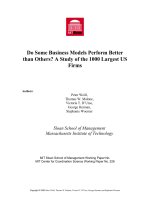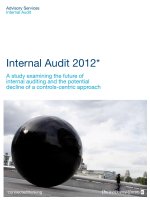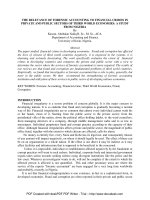the evolution of banking; a study of the development of the credit system (1915)
Bạn đang xem bản rút gọn của tài liệu. Xem và tải ngay bản đầy đủ của tài liệu tại đây (7.18 MB, 208 trang )
H6
1551
H85
XX
THE
EVOLUTION
ROBERT H.
->
»
1
\
I
UNIVEKSIiY
OF
CAL1I-0 ,MA
SAN
DiL'GO
-^THE
Evolution
of
Banking
A
STUDY OF
THE
DEVELOPMENT
OF THE
CREDIT SYSTEM
BY
ROBERT H. HOWE
CHICAGO
CHARLES H.
KERR
&
COMPANY
CO-OPERATIVE
Copyright
1915
By
Robert
H.
Howe
JOHN F. HIGGINS
PRINTER
AND BINDER
376-382
MONROE
STREET
CHICAGO.
ILLINOIS
DEDICATED
TO
THE
MEMORY
OF
HENRY DEMAREST LLOYD
It is
needless to say that
this book does not
contain all that might be
written on the subject
of money; many
interesting and instructive
phases
of
the
subject have not been treated
at
all,
for
the reason that few people will read
a
bulky volume, and many cannot
pay
the cost
of one. It is published with the sole purpose
in view
of
stimulating thought and inquiry
into
the
subject
of which it treats and which
has
been nearly, if not entirely, neglected by
the
leaders of advanced thought.
There is growing
up
in America
a
strong
de-
mand
to
substitute collective ownership
and
operation of certain industries in place
of cor-
poration ownership and operation. This
is
evidenced by the recent passage in
various
states of
Public Utilities Acts which
empower
the cities and
villages
to
purchase
or construct
water works,
electric light
and power plants,
traction
systems,
pipe lines for
the distribution
of
gas,
oil,
heat or
cold
;
warehouses for
storage
purposes, wharfs,
etc.,
and empowering
the
cities
to
issue bonds or certificates
of
indebted-
ness which are
to
be a lien on the
property
5
FOREWORD
built
or purchased and
which are redeemable
out of
the
operating income.
These
enabling acts
will certainly
be
taken
advantage of in
the near future. The present
Public
Utilities owned by
private interests and
operating under
franchises are
staggering
under a
burden of stocks and bonds
far
beyond
the value
of
their properties,
and
in many
cases
double the cost of
reproduction.
In taking over these various
activities
an
attempt
will certainly
be
made
to unload this
mass of
indebtedness,
a
large percentage
of
which is fictitious, upon the
public
at par, and
issue in
place thereof twenty or
twenty-five
year Public Utility Bonds or
Certificates bear-
ing 4 per cent
or
5
per
cent interest. This
would place upon
the
public
a burden of
debt
for principal and interest far
in
excess
of the
value of
the property
taken. Under the pres-
ent
laws
it is
not
possible to take
over these
properties or build others
without issuing
in-
terest-bearing obligations which will
make
the
cost to
the public from
two to four times
the
value received.
If Congress would enact
into legislation
the
Currency Bill found
at the close of this
volume,
cities could take
possession
of these
public
utility properties
and pay no
more than
their
FOREWORD
actual value
and
never be
obliged
to
pay
one
cent of interest.
Currency
is
a
tool which
man invented for
use
where there was an
unequal
exchange of
services or
commodities.
Under a
system of barter where
each ex-
change was
a
complete and
closed
transaction
money was
unknown
and
unneeded.
The fol-
lowing
quotation from Homer's
Illiad depicts
a state
where no money was used
:
"From Lemnos
Isle
a
numerous fleet had come
Freighted
with wine
* * * #
*
* * *
all the other
Greeks
Hastened
to
purchase,
some with brass and
some
With
gleaming iron
;
some
with hides
Cattle
or slaves."
But
where there was
an unequal exchange
of
services or
commodities between two persons
there would
be
the difference
in
the
amount due
from one
to
the other and some evidence or token
would be
required by
the creditor from the
debtor.
In
writing
of this subject
Aristotle said
:
"But with regard
to
a
future exchange
(if
FOREWORD
we
want
nothing at
present, that it may take
place
when we
do want
something) money is,
as
it
were,
our
security, for it is necessary that
he
who
brings it should be
able
to get
what he
wants."
To instance
this
in a simple manner let us
picture
a
shoemaker
living in
a
house built on
a
low, wet
piece
of ground which he desires
drained.
He
employs
a
neighbor to dig
a
ditch
that
will carry off the
surplus water. While
the ditch
is being
dug
the
shoemaker
makes a
pair of shoes,
and offers them to the
ditch dig-
ger as
compensation
for his work. He refuses
the shoes
because he has a good
pair, but ac-
cepts the
shoemaker's
I.
0.
U.
The ditch dig-
ger, however, needs
a coat and a
tailor who
knows the
shoemaker accepts
the evidence of
his debt
in
payment for
the
coat.
The tailor
in turn wants the roof
of his house
mended
and
employs
a
carpenter to do
the work
and
trans-
fers to
him in
payment for it the
shoemaker's
I. 0.
U.
The
carpenter
needing
a
pair of
shoes
gets a
pair from the shoemaker
and pays
for
them by
surrendering the
evidence of
the debt
which
the
shoemaker
originally
owed to the
ditch digger, and the
shoemaker
destroys it.
It
will thus be seen
that the debt
contracted
by the shoemaker was the
basis
for
the
cur-
FOREWORD
rency
by
means of
which the
services of the
ditch
digger, the tailor, the
carpenter and the
shoemaker were
exchanged, and when the
debt
was paid
the currency disappeared. It shows
also that where there
is no
debt
there can
be no
currency.
McLeod, in his Theory
and Practice of Bank-
ing, says: "This
currency
is
nothing more
than
the evidence of
service having been ren-
dered for which
an equivalent has not been
received,
but
which may
at
any time
be de-
manded. It is obvious that as soon as it has
been rendered, the evidence of
its
being
due
must be given
up
to
the
debtor to be destroyed,
and it will
be
no longer current.
And if any
man can render services
to
his neighbors,
he
must in return receive either other services, or
the evidence
of
their being
due
;
and if he ren-
ders
more services than
he
immediately
re-
quires in return, he will accumulate
a
store of
this evidence for
his
future wants.
"These simple considerations at
once show
the fundamental nature of
a
currency.
It is
quite
clear that its
use
is
to
measure
and record
debts, and to
facilitate their transfer from
one
person
to
another;
and
whatever
means be
adopted
for
this purpose, whether
it be
gold,
silver,
paper, or
anything
else,
is
a currency.
10
FOREWORD
We
may, therefore, lay
down as
our
funda-
mental conception that
CURRENCY
AND
TRANSFERRABLE DEBT
are
convertible
terms; whatever
represents
transferrable debt
of
any sort is CURRENCY, and
whatever ma-
terial
the
currency
may
consist of, it
repre-
sents
transferrable debt and
nothing
else.
'
'
CONTENTS
Introduction
13
English
Tallies 16
Modern Banking 19
The
Introduction
of Bank Checks
22
The Cause of Bank Panics
31
The
Bank
of
Venice
37
The Story of the Guernsey Market
50
Opposition
by
Private Bankers
60
Henry
D.
Lloyd
on
the
Guernsey
Financial
Plan 69
French
Assignats
79
State Banks in
America
96
Condition of
American Banks 101
The Bank of
the State of South Carolina .
.
. 108
The State Bank
of
Illinois 119
State Bank Issues in
Michigan 129
Demonetization of the Silver
Dollar in 1873 .
.
139
The
Federal
Reserve
Bank 149
The Fluctuating Value of Gold
159
Henry
D. Lloyd
on Money
165
Conclusion
174
Evolution
of
Banking
INTRODUCTION
The
most important factor in civilized
life
is
the
production and exchange
of commodities.
The
creation and
distribution of the
wealth
necessary
for
the support and comfort
of the
human family is the
main
object of all industry.
Money and its modern substitute, Bank
Credit,
are agencies by
which
this
industry and
commerce is carried on;
but
we
must
not, in
considering the subject,
be
blinded
by
the in-
tervention of
Money and Bank Credit, and fail
to
maintain
a
clear
distinction between the
main object and the agency
by
means of which
we
attain the desired end. Neither
must
we
delude ourselves into thinking that Money,
Banks
and
Bank Credit are
the
only agencies
by which men can exchange wealth.
Bank
Panics
occur which result in
nearly
a
complete stoppage of industry. We
have all
the physical elements for the production of
the
wealth
that is needed to satisfy human
wants.
Yet
hundreds
of
thousands of willing workers,
both
skilled
and
unskilled, are thrown out
of
13
14
THE EVOLUTION OF BANKING
work almost over night. If idle
factories,
idle
land, and idle men are
the
inevitable
result
of
the modern
financial
system, it is the
duty of
all
to
investigate the Banking
and Money
ques-
tion, and substitute a saner, more reliable,
and
less
expensive
system than the present
one.
The modern
banking
system has grown
up
and developed along with the
modern indus-
trial
system. Though the two are inseparably
linked, the Banking
system must be considered
as merely an adjunct
to
the commercial
sys-
tem.
At the dawn
of
history, when
mankind
was
emerging from savagery,
commodities were
produced
by
hand labor
and exchanged
by
means of barter. Human
needs
were
few
and
simple, and were easily satisfied.
To-day, commodities are almost entirely
the
result
of
machine labor.
Human needs have
multiplied and are supplied
by a
worldwide
commerce. But no matter how complex
the
modern
commercial system seems, the same fact
persists,
and has persisted
through
the sweep
of the centuries,
that we still
carry on
a system
of exchanging
goods for
other
goods.
Pro-
ducers do not now
meet
face to face, as they
once
did,
and exchange their
product by direct
barter, but
still the products of
the rural dis-
THE EVOLUTION OF
BANKING
15
tricts
pay
for the products of the manufactur-
ing districts. The
same
is true
of
the nations
—
our exports
pay
for our imports. But
this
inter-social
exchange
of
commodities could not
have grown to its present immense proportions
had not
some means
been
invented
to facilitate
commerce.
In
the
hunting
stage
skins,
and later, in the
pastoral stage, cattle were
used as the Unit of
Calculation, by means of which
values were
expressed and goods exchanged. Later,
a
vast
array of agricultural products and
metals were
used as
the
basis for
the exchange
of commodi-
ties. They
all
served their purpose
at the time
and place where they were used,
but
were
dis-
carded from time to time, and better mediums
substituted
:
Cattle were eliminated because
of
the
differences in the
age and
condition of dif-
ferent
members
of the same flock, and also on
account of their liability
to
death and disease
;
agricultural products
decayed
and
became
worthless; metals used as coins went
through
the same
process
of
elimination
; iron was
used,
but
was
too
cheap and
liable
to rust ; lead
was
too
soft
to
long retain
the impression of
the
mint, etc. But, however interesting and in-
structive this subject is, space
does
not permit
of
a
history here.
16
THE EVOLUTION
OF BANKING
ENGLISH TALLIES
One of the most interesting
instances
of the
use
of
representative money is
found in
the
English
Exchequer Tallies which circulated
in
England for
over six hundred years.
These
were
adopted as a
means of financing the
Eng-
lish Treasury by the fourth son of AVilliam
the
Conqueror, who ascended the
throne
as Henry
I in the year 1100. The tallies were
of wood
and
were issued by Royal Warrant. All
who
served the King
or
State
were
paid with
them.
Supplies
for the Royal Household and
army
were
purchased
with them and they
circulated
among the people as money and were
used
as
such
in
the
exchanging of commodities.
They
were
four sided rods of hazel or linden
wood
about
an
inch in diameter.
The amount
due
from
the
State to the creditor was designated
by notches cut into one of the flat sides of
the
rod.
£1,000
was
represented
by a notch as
broad as the
palm
of the
hand;
£100 by the
breadth of the thumb
;
£20 by the
thickness
of
the little finger;
£1 by that of
a barley-corn;
for
a
shilling
the least piece
possible was
cut
out
;
and
a
penny
merely by
an incision without
any
wood being taken
away.
The amount was
also
written in ink
on two opposite sides.
The
THE EVOLUTION OF BANKING
17
rod was
then split by
knife and
mallet length-
wise through the
notches. One-half
of the
stick,
showing
the
inscription in ink
and one-
half of the
notches was given
to the creditor
and one-half was
placed in
the treasury. They
circulated
throughout
the
Kingdom
as money
and the
merchants and others
used them in all
business
transactions. They did not
pretend
to
be based on
gold or silver. They were
re-
deemed by
the
Government
only by being
ac-
cepted
in the
payment
of taxes. When
the time
came
for the
collection of taxes the Sheriff
of
the
County by
proclamation called all
who had
exchequer tallies
to
present
them and
obtain
allowance for them. They were matched
with
the counter
tallies
and where the two
edges
fitted into each other they
were
said to
**
tally."
After
being
accepted
in
payment of
taxes
they were
broken in half and
thus cancelled.
When the
Bank
of
England
was established
in
1694 there
was
about
£14,000,000
($70,000,-
000)
in
wooden
tallies in
circulation in Eng-
land. The
Bank enjoyed
the privilege
of
issuing paper currency for
the
first
time in
England,
although it
had
been used in China
several hundred years previously.
To Sweden, however, belongs
the credit of
first
introducing paper
bank notes in Europe.
18
THE
EVOLUTION OF
BANKING
The
money
of
Sweden
consisted of large
plates
of
pure
copper,
%
of
an inch thick, and
was
very
inconvenient to
handle in large business
transactions.
The
two-daler
piece
was
7^^
inches
square
and
weighed
3i/^
pounds. A
mer-
chant
on a
collecting tour
was obliged
to
take
a
wheelbarrow
or cart
to
bring his
money
home.
To
remedy
this
inconvenience
a
Bank
of
deposit
was
established at
Stockholm and
the
copper
money
was
deposited and bank
notes
given
in exchange
for
it.
These
bank
notes
were
used
all through the
country in
making
payments.
The
Bank of
England did
not at
first
issue
notes for a
less amount
than £20
($100)
and
these
were of
little use
for
general business
purposes, so
the
Chancellor of
the Exchequer
began the
issue of
£5 and £10
exchequer
bills.
The use
of the
paper
bank
notes
and
the ex-
chequer
bills
gradually displaced
the
wooden
tallies in the more
important business
trans-
actions, but
it
was
not until
1783 that
their use
was
abolished
by
act of
parliament.
In spite
of
this
act
their use was
not
finally abandoned
by
the
government until
1826.
Four years
later
the
heaps of them
which had
been ac-
cumulating for centuries
were
ordered burned
in
the
furnaces of the Houses
of
Parliament.
A
THE
EVOLUTION OF BANKING
19
defective or overheated
flue started
a
conflagra-
tion which completely
destroyed the buildings.
There is still preserved
in the British
Mu-
seum
a
tally which
looks
like
a
huge
wooden
sabre. It
was given
by
the British
government
to
the East India Company
as security for
a
loan
of
£25,000
($125,000).
The loan
was
afterwards
repaid.
In
1C97, when the capital
of the Bank
of
England was
increased by
a
new
subscription
of
£1,000,000
($5,000,000),
eight
hundred
thou-
sand
pounds, or
four million dollars,
of
the
stock was
paid for with
wooden tallies
at par.
MODERN BANKING
Modern banking
can
be said to have
had its
origin
with the establishment of the
Bank of
England in
1694,
and the
Bank
of
Scotland
in 1695.
Previous
to
that date the
Banks,
such as
The
Bank of
Venice
(1191-1797),
Bank
of Genoa
(1407-1797),
Bank of Hamburg
(1619),
Bank
of
Stockholm
(1668-1754),
and the
Bank of
Am-
sterdam
(1609-1790)
were
Banks of Deposit.
Payments in
business
transactions
during
the
medieval
period
were
made by
means
of coins,
20
THE EVOLUTION
OF BANKING
but the
inconvenience
of handling and
storing
a
large number
of
coins,
vrith the risk
of loss
through overvalued or
debased coins and
the
risk
of theft,
led
to the establishment of these
Banks of Deposit, where the coins were
valued
for once
and all
and were then locked
up
in
the
bank vaults
and
never withdrawn,
but
the
title
to
the same was transferred on
the Books
of the
Banks. This is in effect
what the United
States Treasury is doing at the present
time
when it issues
gold
and
silver
certificates
to
any-
one who deposits gold
and
silver
coins
or
bul-
lion in the Treasury. The Banks
of Deposit
made no
loans,
but their income was derived
from
a
charge that
was made for each transfer
of funds on the books of
the
Bank.
Our modern banks are Banks
of
Discount
as
distinguished from their predecessors,
the
Banks of
Deposit,
and have given an enormous
impetus
to
commerce. They have been able
to
do
this because they can and
do
create credit
that circulates the same as
money
and in
a
far
more convenient,
safe and
economical form.
At the beginning
of
the banking era
the
pres-
ence or absence of banking facilities were
of
little or no importance
to
the working
class,
but
these facilities were utilized by
the mer-
chant or trading
class.
THE EVOLUTION OF BANKING
21
The
merchant
was able
to
purchase
goods
from, the
producers
in
an
amount far
exceeding
his
capital
because he could
give
to the Bank
his note payable three or four months
later,
and
receive Bank
Notes
for
the amount of
his
note less the interest.
These
Bank Notes circulated the
same as
coins.
They paid for
goods
and discharged all
kinds of financial obligations equally
as
vrell
as gold, and were far more
convenient
to
han-
dle. They were
redeemable in coin (Gold or
Silver) on demand,
but the bank maintained
only
a
small reserve in
gold for redemption
purposes.
This
led to a suspension
of specie
payments
by
the Bank of England
twice in its
career, the most important one continuing
for
twenty-five years—1797 to
1822
—
but the busi-
ness of
England, and
of
the Bank,
continued
just
the
same.
Private Banks were
established,
but
could
loan only their own or customers ' capital. They
could not loan their credit like the
Bank of
England,
as
the latter,
by
its charter,
had
a
monopoly of the issue of Bank Notes.









